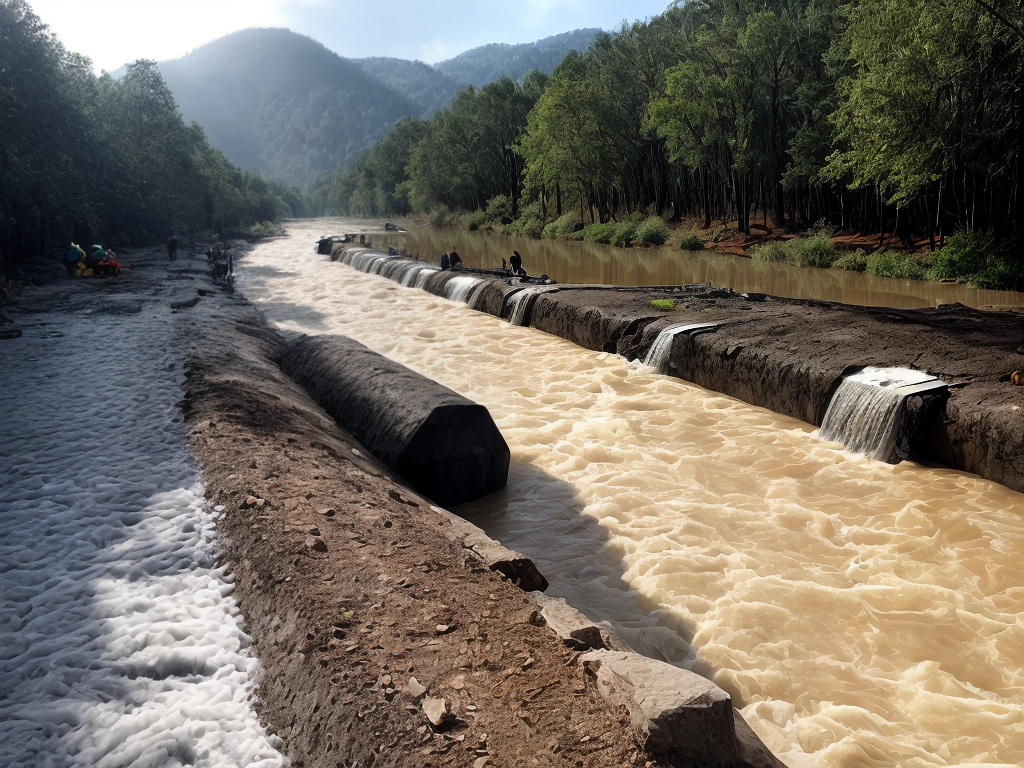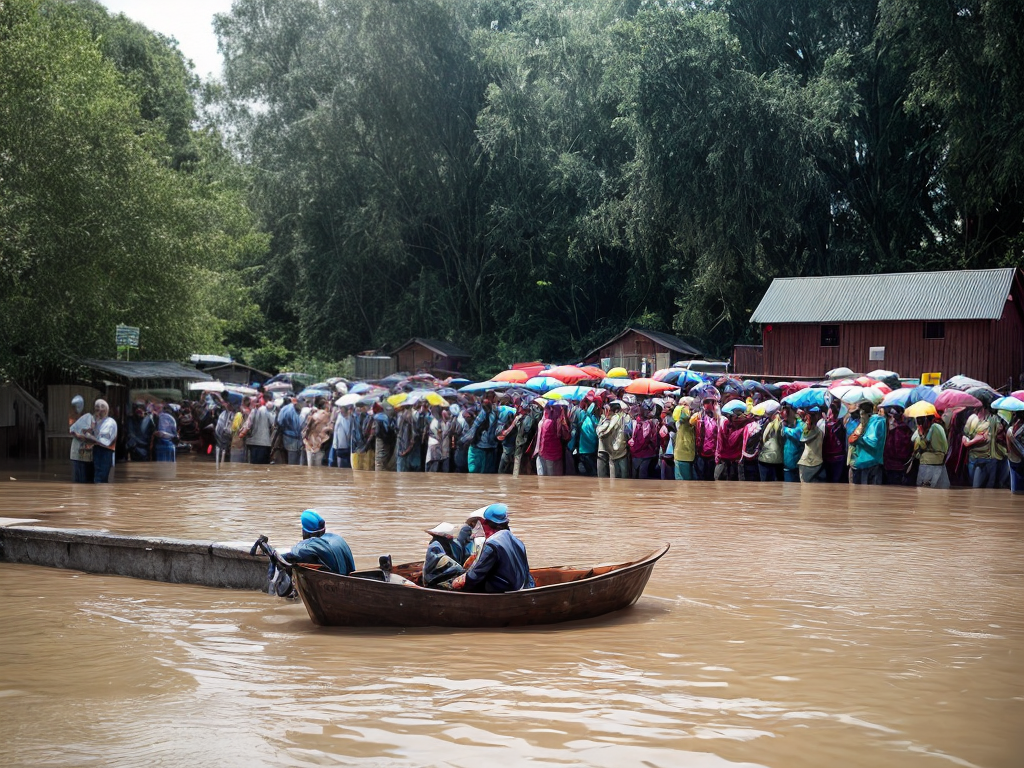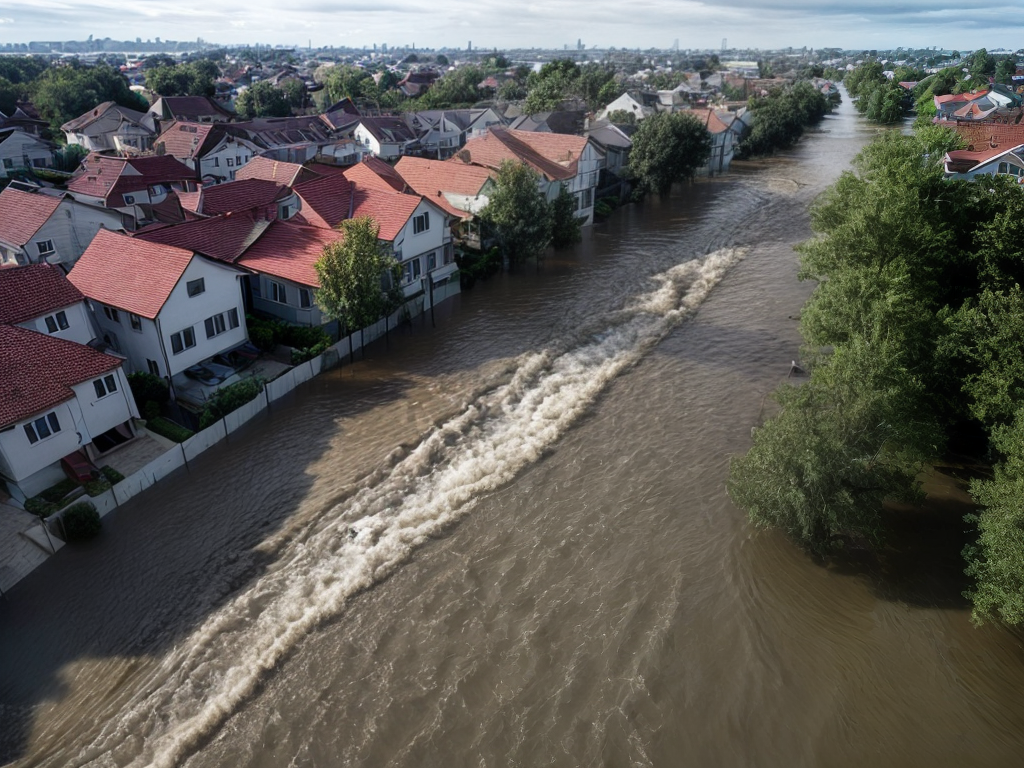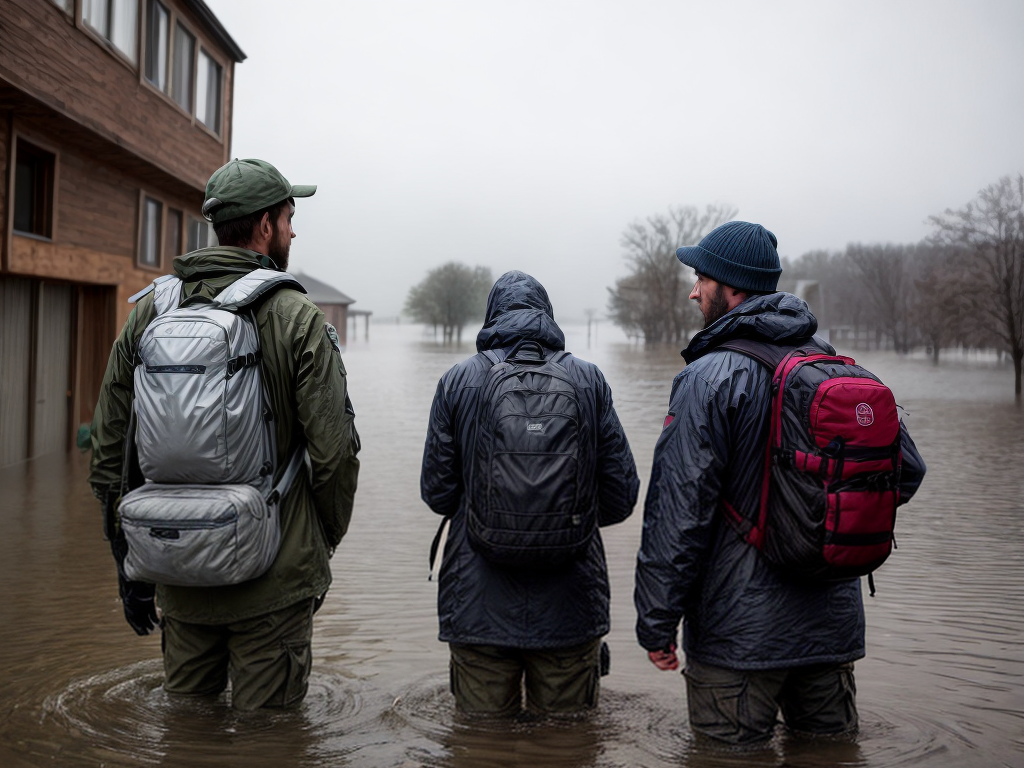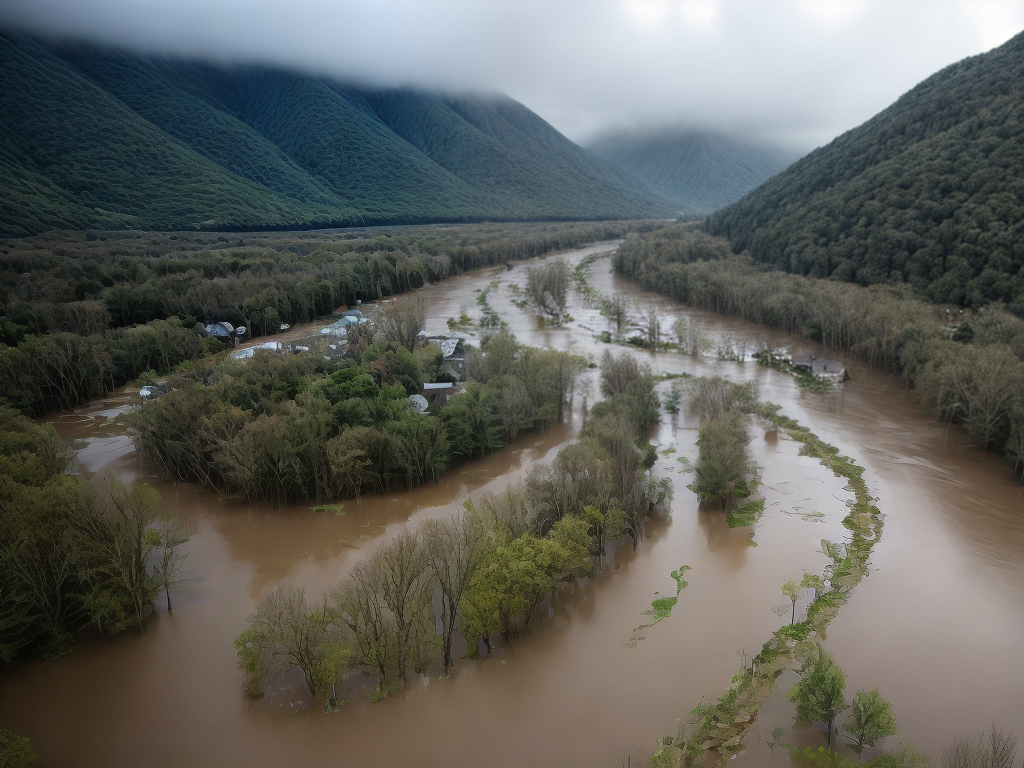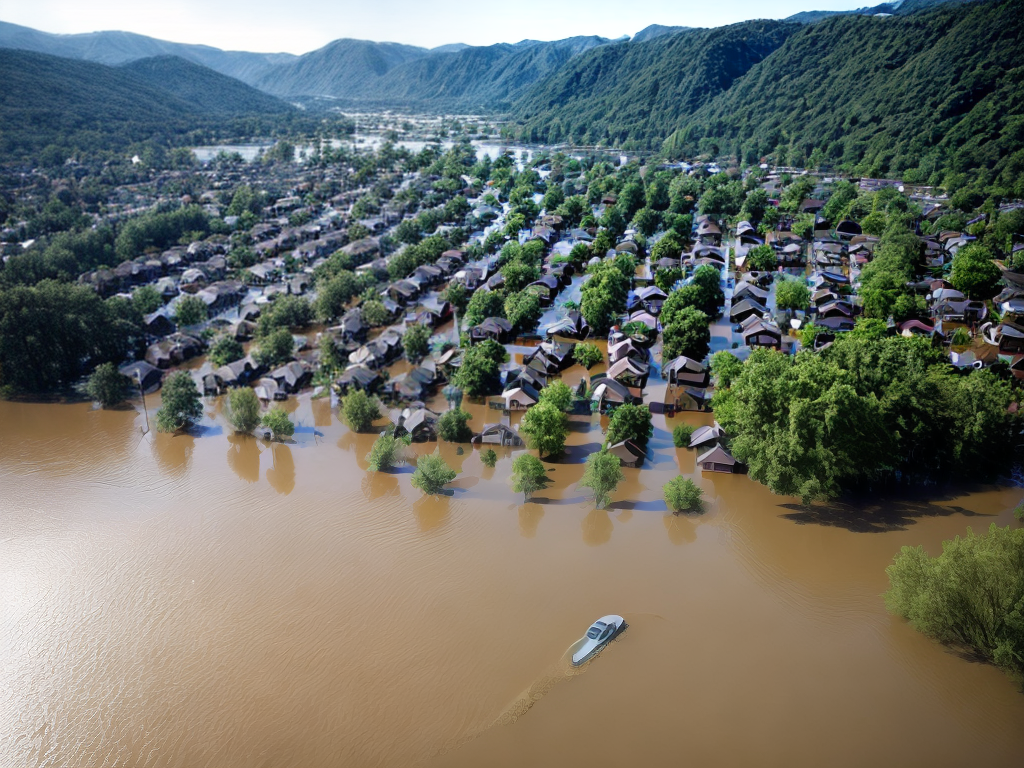
When it comes to managing flood risks, there is an often overlooked aspect that plays a crucial role in mitigating the impacts: international cooperation. You may not realize it, but floods do not adhere to national borders, and their consequences can extend far beyond a single country’s borders. In this discussion, we will explore the importance of international cooperation in flood risk management and how it can significantly enhance our ability to prevent and respond to these natural disasters. From sharing data and research findings to developing early warning systems, there are numerous areas where collaboration can make a real difference. So, let us explore the ways in which international cooperation can help us build a safer and more resilient world in the face of increasing flood risks.
Key Takeaways
- International collaboration is essential for effectively addressing flood challenges, as it allows for the pooling of resources, knowledge, and expertise.
- Sharing data and research findings plays a crucial role in improving flood risk assessment and mitigation strategies.
- Cross-border cooperation in flood risk management enables neighboring countries to coordinate resources and align strategies.
- Strengthening international policy frameworks and mobilizing financial resources are crucial for implementing effective flood risk management measures.
Understanding the Global Impact
We will now explore the global impact of flood risk management cooperation. When it comes to tackling the challenges posed by floods, collaboration on a global scale is crucial. Through global collaboration, we can pool our resources, knowledge, and expertise to develop innovative solutions that can effectively address flood risks worldwide.
One of the key benefits of global collaboration in flood risk management is the opportunity to share experiences. Different countries and regions have unique perspectives on flood risk management based on their geographical location, climate, and infrastructure. By sharing our experiences, we can learn from each other’s successes and failures, and apply these lessons to improve our own flood risk management strategies. This exchange of knowledge can lead to the development of innovative approaches that are tailored to specific local conditions.
Furthermore, global collaboration enables us to access a wider range of resources and expertise. By working together, we can tap into the collective knowledge and skills of experts from around the world. This can result in the development of cutting-edge technologies, tools, and methods that can enhance our ability to predict, monitor, and respond to flood events. Through shared research and development efforts, we can push the boundaries of innovation and find new ways to mitigate the impacts of floods.
Sharing Data and Research Findings
As we explore the subtopic of sharing data and research findings in flood risk management cooperation, it is crucial to recognize the numerous benefits of data sharing. By sharing data, we can gain a comprehensive understanding of flood patterns and risks, leading to better-informed decision-making and improved flood mitigation strategies. Additionally, data sharing opens doors for collaborative research opportunities, allowing experts from various fields to come together and develop innovative solutions to address the global impact of floods.
Data Sharing Benefits
Sharing data and research findings offers numerous benefits for flood risk management cooperation. In today’s rapidly evolving world, where innovation is highly valued, the exchange of data and research findings plays a crucial role in addressing the challenges posed by flood risks. While concerns about data privacy and security are important, the benefits of sharing data outweigh these concerns. By sharing information, we can gain valuable insights into flood patterns, vulnerability assessments, and the effectiveness of different risk management strategies. This allows us to make more informed decisions and develop innovative solutions that can better protect communities. Moreover, data sharing promotes transparency and collaboration among stakeholders, fostering a culture of cooperation and collective problem-solving. Therefore, it is essential to prioritize data privacy and security measures while actively promoting the sharing of data and research findings for effective flood risk management cooperation.
Collaborative Research Opportunities
In order to build upon the benefits of data sharing and research findings, exploring collaborative research opportunities becomes crucial for effective flood risk management cooperation. Through international collaboration and joint research efforts, we can harness the power of collective knowledge and expertise to develop innovative solutions. By sharing data and research findings, we can identify common challenges, exchange best practices, and foster a culture of innovation in flood risk management. Collaborative research allows us to pool resources, leverage diverse perspectives, and accelerate progress in understanding and mitigating flood risks. To highlight the importance of collaborative research opportunities, consider the following table:
| Collaborative Research Opportunities | Benefits |
|---|---|
| Joint funding initiatives | Increased access to resources and expertise |
| Knowledge exchange programs | Sharing of best practices and lessons learned |
| International research networks | Leveraging diverse perspectives and expertise |
| Collaborative research projects | Accelerating progress in understanding and mitigating flood risks |
Improved Flood Mitigation Strategies
Collaborative research and data sharing are essential components for developing improved flood mitigation strategies. By sharing data and research findings, we can gain a deeper understanding of flood patterns and identify areas of high risk. This allows us to develop more accurate flood maps and enhance our risk assessment capabilities.
To emphasize the importance of sharing data and research, consider the following:
- Collaborative Data Collection: Sharing data from multiple sources enables us to create comprehensive flood maps that account for different variables and factors.
- Advanced Modeling Techniques: By combining research findings, we can develop sophisticated flood models that accurately simulate potential scenarios and assess their impact.
- Integrated Risk Assessment: Sharing data and research findings facilitates a holistic approach to risk assessment, allowing us to identify vulnerabilities and prioritize mitigation efforts.
- Informed Decision Making: Access to shared data and research empowers policymakers and stakeholders to make evidence-based decisions, leading to more effective flood mitigation strategies.
Through collaborative research and data sharing, we can drive innovation in flood mitigation and create strategies that better protect our communities.
Developing Early Warning Systems
To effectively manage flood risks, it is crucial to develop early warning systems that provide timely and accurate information to communities in need. These systems play a vital role in mitigating the impact of floods by giving communities the opportunity to prepare and respond effectively. In today’s rapidly changing world, traditional approaches to early warning systems may no longer be sufficient. We need innovative solutions that harness the power of technology and data to enhance early warning system effectiveness and community preparedness.
One such innovative approach is the use of advanced sensors and real-time monitoring systems. These technologies can detect changes in water levels, rainfall patterns, and other critical factors that contribute to flood risks. By continuously collecting and analyzing data, these systems can provide early warnings with greater accuracy and precision. This allows communities to take proactive measures such as evacuations, securing important assets, and implementing emergency response plans.
To better understand the potential impact of these innovative early warning systems, let’s take a look at the following table:
| System Feature | Emotion Evoked |
|---|---|
| Real-time data analysis | Confidence |
| Advanced sensors | Security |
| Timely warnings | Relief |
| Proactive measures | Preparedness |
| Effective response | Resilience |
As you can see, these features evoke emotions that align with our desire for innovation. They instill confidence, security, relief, preparedness, and resilience within communities facing flood risks. By integrating these advanced technologies into our early warning systems, we can enhance their effectiveness and empower communities to better prepare for and respond to floods.
Collaborative Risk Assessment
Let’s talk about the points of collaborative risk assessment in flood risk management cooperation. One important aspect is joint data analysis, where we can combine our knowledge and resources to gather accurate information about flood risks. Additionally, through shared risk mitigation efforts, we can work together to develop strategies and measures that will help minimize the impact of floods on our communities. By collaborating in risk assessment, we can ensure a more comprehensive and effective approach to managing flood risks.
Joint Data Analysis
How can we effectively analyze data together to assess and mitigate flood risks? Collaborative analysis and data sharing are key to achieving this goal. By pooling our resources and expertise, we can gain a deeper understanding of the dynamics of flooding and develop innovative solutions. Here are four ways in which joint data analysis can enhance flood risk management:
- Increased data accuracy: By sharing data from different sources, we can improve the quality and accuracy of our analyses, leading to more reliable risk assessments.
- Comprehensive risk assessment: Collaborative analysis allows us to consider a wide range of factors, such as hydrological data, land use patterns, and infrastructure vulnerabilities, enabling us to develop more holistic risk assessments.
- Early warning systems: By combining data from multiple sources, we can develop advanced early warning systems that provide timely and accurate information to communities at risk, allowing for better preparedness and response.
- Decision-making support: Joint data analysis can provide decision-makers with valuable insights, helping them make informed choices about flood risk management strategies and investments.
Shared Risk Mitigation
By collaborating on risk assessments, we can effectively mitigate shared flood risks and develop proactive strategies to minimize potential damages. Shared risk mitigation involves pooling resources, knowledge, and expertise to implement collaborative approaches that distribute the burden of managing flood risks among multiple stakeholders. This approach promotes risk sharing and fosters a sense of collective responsibility. Through collaborative risk assessments, we can identify common vulnerabilities and prioritize actions that address the most critical areas of concern. By sharing data, conducting joint research, and engaging in open dialogue, we can enhance our understanding of flood risk dynamics and develop innovative solutions. Collaborative risk assessment not only improves our ability to respond to flood events but also enables us to develop long-term strategies that build resilience and adaptability in the face of changing climate conditions.
Building Resilient Infrastructure
Building resilient infrastructure is crucial for effective flood risk management cooperation. In order to mitigate the impact of floods and protect communities, it is essential to prioritize the development and maintenance of infrastructure that can withstand extreme weather events. Here are four key reasons why building resilient infrastructure is vital:
- Enhanced safety: By implementing robust building codes and standards, we can ensure that infrastructure is designed to withstand the forces of flooding. This includes constructing buildings on higher ground, reinforcing foundations, and using flood-resistant materials. Additionally, regular infrastructure maintenance and inspections can identify vulnerabilities and enable timely repairs and upgrades.
- Improved functionality: Resilient infrastructure not only withstands the impact of floods but also remains functional during and after an event. This means that critical services such as transportation, communication, and healthcare can continue to operate, enabling faster recovery and minimizing disruption to daily life.
- Reduced economic losses: Investing in resilient infrastructure can significantly reduce the economic losses caused by floods. By building structures that are resistant to flood damage, we can minimize repair and reconstruction costs. Furthermore, resilient infrastructure ensures the continuity of business operations, preventing prolonged disruptions and economic downturns.
- Promotion of innovation: Building resilient infrastructure requires innovative approaches and technologies. This presents an opportunity for the development and implementation of new solutions that not only enhance flood resilience but also promote sustainable practices. Innovation in infrastructure design, construction materials, and maintenance techniques can lead to long-term cost savings and a more environmentally friendly approach.
Promoting Cross-Border Cooperation
When it comes to promoting cross-border cooperation in flood risk management, there are several key points to consider. First, joint flood response is crucial, as it allows neighboring countries to work together in addressing flood emergencies and coordinating resources. Second, shared flood data is essential for effective decision-making and planning, as it enables countries to have a comprehensive understanding of the flood situation in the region. Lastly, cross-border flood plans should be developed to ensure that strategies and measures are aligned, minimizing the impact of floods across borders.
Joint Flood Response
Our collective efforts in promoting cross-border cooperation for joint flood response have resulted in significant improvements in flood risk management. By improving communication and developing joint infrastructure, we have been able to enhance our ability to respond to floods in a more efficient and effective manner. Here are four key ways in which we have achieved this:
- Enhanced data sharing: We have established mechanisms to share real-time flood data across borders, allowing us to anticipate and respond to flood events more accurately.
- Coordinated emergency response: Through joint training exercises and the establishment of cross-border emergency response teams, we have improved our ability to coordinate and mobilize resources during flood events.
- Integrated flood risk assessment: We have developed a common framework for assessing flood risk, allowing us to prioritize and allocate resources effectively across borders.
- Collaborative infrastructure projects: By pooling our resources and expertise, we have been able to implement joint infrastructure projects that not only reduce flood risk but also promote sustainable development.
These collaborative efforts have revolutionized our approach to flood risk management, fostering innovation and ensuring the safety and resilience of our communities in the face of flooding.
Shared Flood Data
Through the sharing of flood data across borders, we have greatly enhanced our ability to anticipate and respond to flood events in a more efficient and effective manner. The development of data sharing platforms and cross-border collaboration has revolutionized flood risk management. These innovative platforms enable real-time data exchange, allowing us to monitor and analyze flood patterns on a global scale. By pooling our resources and sharing information, we can better understand the complex dynamics of floods, identify vulnerable areas, and implement targeted mitigation strategies. This collaboration fosters a proactive approach, empowering us to take preventive measures and minimize the impact of floods. Additionally, shared flood data enables us to coordinate emergency response efforts, ensuring a swift and coordinated response across borders. By embracing data sharing and cross-border collaboration, we are actively shaping a future where flood risk management is driven by innovation and collective action.
Cross-Border Flood Plans
To promote cross-border cooperation in flood management, it is essential to establish comprehensive and collaborative cross-border flood plans. These plans should prioritize the following:
- Information sharing: Implementing a system for sharing real-time data on water levels, precipitation, and flood forecasts across borders ensures a coordinated response to flood events.
- Joint risk assessment: Conducting joint assessments of flood risks and vulnerabilities helps identify common challenges and develop effective strategies for mitigating them.
- Coordination of resources: Coordinating resources such as manpower, equipment, and emergency response plans ensures a swift and efficient cross-border response in times of flooding.
- Policy harmonization: Aligning policies and regulations across borders facilitates seamless cross-border collaboration in areas such as flood forecasting, land use planning, and emergency management.
Strengthening International Policy Frameworks
International collaboration is essential for establishing robust policy frameworks to strengthen flood risk management. In a world where the effects of climate change are increasingly evident, it is imperative that we work together to address the challenges posed by floods. By pooling our resources and knowledge, we can develop innovative solutions that are both effective and sustainable.
A key aspect of strengthening international policy frameworks is global collaboration. This involves bringing together stakeholders from different countries and regions to share expertise, best practices, and lessons learned. By leveraging the diverse perspectives and experiences of these stakeholders, we can develop policies that are tailored to the unique needs and circumstances of each country. This approach fosters a sense of ownership and ensures that policies are not merely imposed from above, but rather, co-created by all parties involved.
Another important aspect of strengthening international policy frameworks is policy implementation. It is not enough to have well-crafted policies on paper; they must be effectively implemented on the ground. This requires coordination and cooperation among various actors, including governments, non-governmental organizations, and local communities. By working together, we can ensure that policies are translated into action and that the necessary resources and capacities are mobilized to effectively manage flood risks.
To illustrate these ideas, we have provided a table below showcasing the key elements of strengthening international policy frameworks:
| Elements | Description |
|---|---|
| Global Collaboration | Bringing together stakeholders from different countries to share expertise and best practices. |
| Policy Co-creation | Involving all parties in the development of policies to ensure ownership and relevance. |
| Effective Implementation | Coordinating efforts to translate policies into action and mobilize necessary resources. |
Mobilizing Financial Resources
Now let’s talk about mobilizing financial resources for flood risk management. When it comes to funding strategies, we need to explore innovative approaches that can attract both public and private investments. Additionally, building strong international partnerships is crucial in sharing financial burdens and pooling resources. Lastly, it’s important to consider financial assistance programs that can provide support to communities in need, ensuring that they have the necessary resources to implement effective flood risk management measures.
Funding Strategies
Developing effective funding strategies is crucial for mobilizing financial resources in flood risk management cooperation. In order to ensure innovative approaches and sustainable solutions, it is important to consider the following strategies:
- Public-Private Partnerships (PPP): By collaborating with private entities, governments can tap into additional financial resources and expertise, fostering innovation in flood risk management.
- Crowdfunding: Utilizing online platforms, communities can raise funds collectively for flood risk management initiatives, encouraging public participation and ownership.
- Climate Finance: Governments can access international funds specifically allocated for climate-related projects, such as flood risk management, promoting collaboration between countries and advancing innovative solutions.
- Risk Transfer Mechanisms: Insurance and reinsurance schemes can provide financial protection against flood damages, incentivizing investment in preventive measures and reducing the burden on public budgets.
International Partnerships
To effectively mobilize financial resources, fostering international partnerships is essential in flood risk management cooperation. In today’s interconnected world, global collaboration is crucial in addressing the complex challenges posed by floods. By forming partnership initiatives, countries can share knowledge, expertise, and financial resources to develop innovative solutions for managing flood risks. These partnerships can facilitate the exchange of best practices, technologies, and data, enabling effective risk assessment and mitigation strategies. Furthermore, international collaborations can help leverage financial support from various sources, including international organizations, development banks, and private sector entities. Through these partnerships, countries can pool their resources and expertise, leading to more efficient and sustainable flood risk management practices. By embracing international partnerships, we can harness the power of collective action to build resilience and protect communities from the devastating impacts of floods.
Financial Assistance Programs
In order to effectively mobilize financial resources and continue advancing flood risk management cooperation, it is crucial to explore the various financial assistance programs available. These programs provide much-needed financial aid to countries and organizations working towards managing flood risks. Here are four key points to consider:
- Government Grants: Many governments offer grants to support flood risk management projects. These grants can help fund research, infrastructure development, and community resilience initiatives.
- International Funding Institutions: Organizations such as the World Bank and the Asian Development Bank provide financial assistance programs specifically designed for flood risk management. These institutions offer loans, grants, and technical expertise to support projects at both national and regional levels.
- Insurance Programs: Some countries have implemented innovative insurance schemes to provide financial assistance in the aftermath of floods. These programs help individuals and communities recover from losses and rebuild their lives.
- Public-Private Partnerships: Collaborations between public and private sectors can mobilize additional financial resources for flood risk management. These partnerships often involve innovative financing models that attract investments from businesses and promote sustainable solutions.
Enhancing Capacity Building Efforts
Through collaborative efforts, we have been working towards enhancing capacity building in flood risk management. To address the complex challenges posed by floods, it is crucial to invest in capacity building initiatives and training programs that promote innovation and knowledge sharing.
Capacity building initiatives play a pivotal role in equipping individuals and organizations with the necessary skills and knowledge to effectively manage flood risk. By providing training programs that focus on the latest technologies, best practices, and adaptive strategies, we can empower stakeholders to make informed decisions and take proactive measures in mitigating the impacts of floods. These programs not only enhance technical expertise but also foster collaboration and cooperation among various stakeholders, promoting a holistic approach to flood risk management.
In our efforts to enhance capacity building, we have embraced innovative approaches such as online learning platforms and virtual training programs. These platforms provide flexible and accessible learning opportunities, allowing individuals from different geographical locations to participate and contribute to the global discourse on flood risk management. Furthermore, they enable the exchange of ideas and experiences, fostering a culture of innovation and continuous improvement.
To ensure the effectiveness of capacity building initiatives, it is essential to establish partnerships and networks that facilitate knowledge transfer and collaboration. By leveraging the expertise and resources of international organizations, governments, academia, and the private sector, we can create a comprehensive and integrated approach to capacity building in flood risk management. This collaborative approach not only maximizes the impact of our efforts but also promotes the sustainable development of communities and ecosystems affected by floods.
Implementing Climate Change Adaptation Measures
What steps can we take to effectively implement climate change adaptation measures? As we strive to address the challenges posed by climate change, it is crucial to develop and implement effective climate change adaptation strategies. By focusing on community resilience building, we can ensure that our societies are better prepared for the impacts of climate change and can continue to thrive in the face of adversity.
Here are four key steps that can help us effectively implement climate change adaptation measures:
- Assess Vulnerabilities: It is essential to conduct comprehensive assessments to understand the vulnerabilities of our communities to climate change. This includes identifying areas at higher risk of floods, storms, or sea-level rise. By understanding these vulnerabilities, we can develop targeted adaptation strategies that address the specific needs of each community.
- Engage Stakeholders: Building community resilience requires the active participation of all stakeholders, including local governments, businesses, and community members. By engaging stakeholders in the decision-making process, we can ensure that adaptation measures are well-informed and supported by those directly affected.
- Integrate Adaptation Into Planning: Climate change adaptation should be integrated into all levels of planning, from local to national. By incorporating adaptation measures into land-use planning, infrastructure development, and disaster risk reduction strategies, we can ensure that our communities are better equipped to withstand the impacts of climate change.
- Promote Innovation and Knowledge Sharing: To effectively implement climate change adaptation measures, we must foster innovation and encourage the sharing of knowledge and best practices. This includes investing in research and development, supporting pilot projects, and facilitating collaboration between different stakeholders.
Promoting Community Engagement and Participation
To effectively promote community engagement and participation, we must actively involve all stakeholders in the decision-making process of implementing climate change adaptation measures. Community involvement and stakeholder engagement play a crucial role in creating innovative and sustainable solutions for flood risk management.
Engaging the community in flood risk management initiatives fosters a sense of ownership and responsibility. By involving community members, we tap into their local knowledge and experiences, which can provide valuable insights and perspectives. This collaboration allows for a more comprehensive understanding of the challenges and opportunities in implementing effective flood risk management strategies.
In order to encourage community participation, it is essential to create platforms for open dialogue and information sharing. This can be done through public consultations, community meetings, and online forums. By actively seeking input from community members, we empower them to contribute to the decision-making process, ensuring that their voices are heard and their needs are addressed.
Moreover, stakeholder engagement is equally important in promoting community involvement. By involving stakeholders from various sectors such as government agencies, non-profit organizations, and private entities, we can harness their expertise, resources, and networks. This multi-sectoral collaboration enables the development of innovative solutions that are comprehensive and sustainable.
Leveraging Technology and Innovation
We can enhance flood risk management by embracing technology and fostering innovation. Technology advancements and innovative solutions have the potential to revolutionize how we approach flood risk management, enabling us to better predict, prevent, and respond to floods. Here are four ways in which leveraging technology and innovation can significantly improve flood risk management:
- Advanced Modeling and Simulation: By utilizing cutting-edge technology, such as high-resolution satellite imagery and remote sensing data, we can create accurate and detailed flood models. These models can help us understand flood patterns, assess vulnerability, and identify areas at high risk. With this information, we can plan and implement effective mitigation measures to reduce the impact of floods.
- Real-time Monitoring and Early Warning Systems: Technology allows us to continuously monitor weather conditions, river levels, and other crucial data in real-time. By combining this data with advanced algorithms, we can develop early warning systems that provide timely alerts and forecasts to communities at risk. This enables individuals to take necessary precautions, evacuate if necessary, and minimize potential damage.
- Smart Infrastructure: Innovative solutions, such as smart sensors and IoT (Internet of Things) devices, can be integrated into infrastructure systems like dams, levees, and drainage systems. These technologies enable us to monitor the structural integrity of these assets, detect anomalies, and trigger automatic responses when necessary. By doing so, we can proactively maintain and manage our infrastructure, reducing the risk of failures during floods.
- Community Engagement through Apps and Platforms: Technology allows us to engage with communities in a more efficient and inclusive manner. Mobile apps and online platforms can provide real-time information, educational resources, and interactive tools for community members to understand flood risks, plan for emergencies, and collaborate with authorities. This fosters a sense of empowerment and shared responsibility, leading to better community resilience.
Facilitating Knowledge Exchange Platforms
Facilitating the exchange of knowledge through interactive platforms is essential for enhancing flood risk management strategies. In today’s interconnected world, harnessing the power of technology and collaboration opportunities is crucial for staying ahead in the field of flood risk management. By creating knowledge exchange platforms, we can foster a culture of knowledge sharing and enable professionals from various disciplines and regions to collaborate effectively.
To illustrate the importance of knowledge exchange platforms, let us consider a hypothetical scenario where flood risk management professionals from different countries come together to share their expertise and experiences. The table below showcases the potential benefits of such platforms:
| Benefits of Knowledge Exchange Platforms | Description |
|---|---|
| Enhanced Learning | Professionals can learn from each other’s experiences, gaining valuable insights and best practices that can be applied in their own regions. |
| Improved Decision Making | By exchanging knowledge, professionals can make informed decisions based on a broader understanding of flood risk management techniques and strategies. |
| Innovation and Creativity | Collaboration and knowledge sharing can spark innovation, leading to the development of new approaches and technologies in flood risk management. |
| Networking Opportunities | Knowledge exchange platforms provide a space for professionals to connect, fostering new partnerships and collaborations that can drive progress in the field. |
These platforms can take various forms, such as online communities, forums, webinars, and conferences. They enable professionals to engage in discussions, share research findings, and collaborate on projects. Additionally, advancements in technology, such as virtual reality and artificial intelligence, can further enhance the knowledge exchange experience, enabling immersive and interactive learning opportunities.
Addressing Socioeconomic Inequalities
Addressing socioeconomic inequalities is a crucial aspect of effective flood risk management. Socioeconomic disparities can exacerbate the impact of floods, leaving vulnerable communities more exposed and less resilient to these natural disasters. To ensure the success of flood risk management strategies, it is essential to adopt inclusive strategies that prioritize the needs of all individuals and communities, regardless of their socioeconomic status.
Here are four key reasons why addressing socioeconomic inequalities is integral to effective flood risk management:
- Equitable distribution of resources: By addressing socioeconomic disparities, we can ensure that resources for flood risk management are distributed equitably. This means that communities with lower socioeconomic status receive the support and resources they need to mitigate flood risks effectively.
- Enhanced community engagement: Inclusive strategies encourage active participation from all members of society in the decision-making processes related to flood risk management. This enables a more comprehensive understanding of the unique challenges faced by different socioeconomic groups and leads to more targeted and effective solutions.
- Reduced vulnerability: Addressing socioeconomic disparities helps to reduce vulnerability to floods by providing vulnerable communities with the necessary tools and support to build resilience. This can include measures such as improved infrastructure, access to early warning systems, and enhanced social support networks.
- Promotion of sustainable development: Inclusive flood risk management strategies prioritize sustainable development by considering the long-term socioeconomic impacts of flooding. By addressing socioeconomic disparities, we can ensure that vulnerable communities have the opportunity to thrive and develop resilient economies in the face of future flood events.
Evaluating and Improving International Cooperation Efforts
To further enhance flood risk management, it is crucial for us to evaluate and improve international cooperation efforts. International collaboration plays a vital role in addressing the multifaceted challenges posed by floods, as it allows for the sharing of knowledge, resources, and best practices among countries. However, in order to maximize the effectiveness of these efforts, it is essential that we undertake a comprehensive policy evaluation.
Policy evaluation is a critical step in assessing the impact and effectiveness of international cooperation initiatives in flood risk management. By evaluating the policies and strategies implemented by different countries, we can identify areas of success and areas that need improvement. This evaluation process should involve all relevant stakeholders, including government agencies, academic institutions, and non-governmental organizations, to ensure a holistic and inclusive assessment.
In evaluating international cooperation efforts, we need to consider various factors. One important aspect is the scalability and transferability of successful policies and strategies. By identifying the approaches that have been successful in one country and exploring their applicability in other contexts, we can promote innovation and efficiency in flood risk management.
Additionally, we must assess the level of coordination and collaboration among countries. Effective international cooperation requires clear communication channels, regular exchange of information, and joint decision-making processes. By evaluating the existing mechanisms for collaboration, we can identify gaps and implement measures to strengthen coordination.
Moreover, policy evaluation should consider the impact of international cooperation on vulnerable populations. It is crucial to ensure that the needs and concerns of marginalized communities are taken into account in the development and implementation of flood risk management strategies. Evaluating the inclusiveness and equity of international cooperation efforts can help us identify ways to address socioeconomic inequalities and promote social justice.

